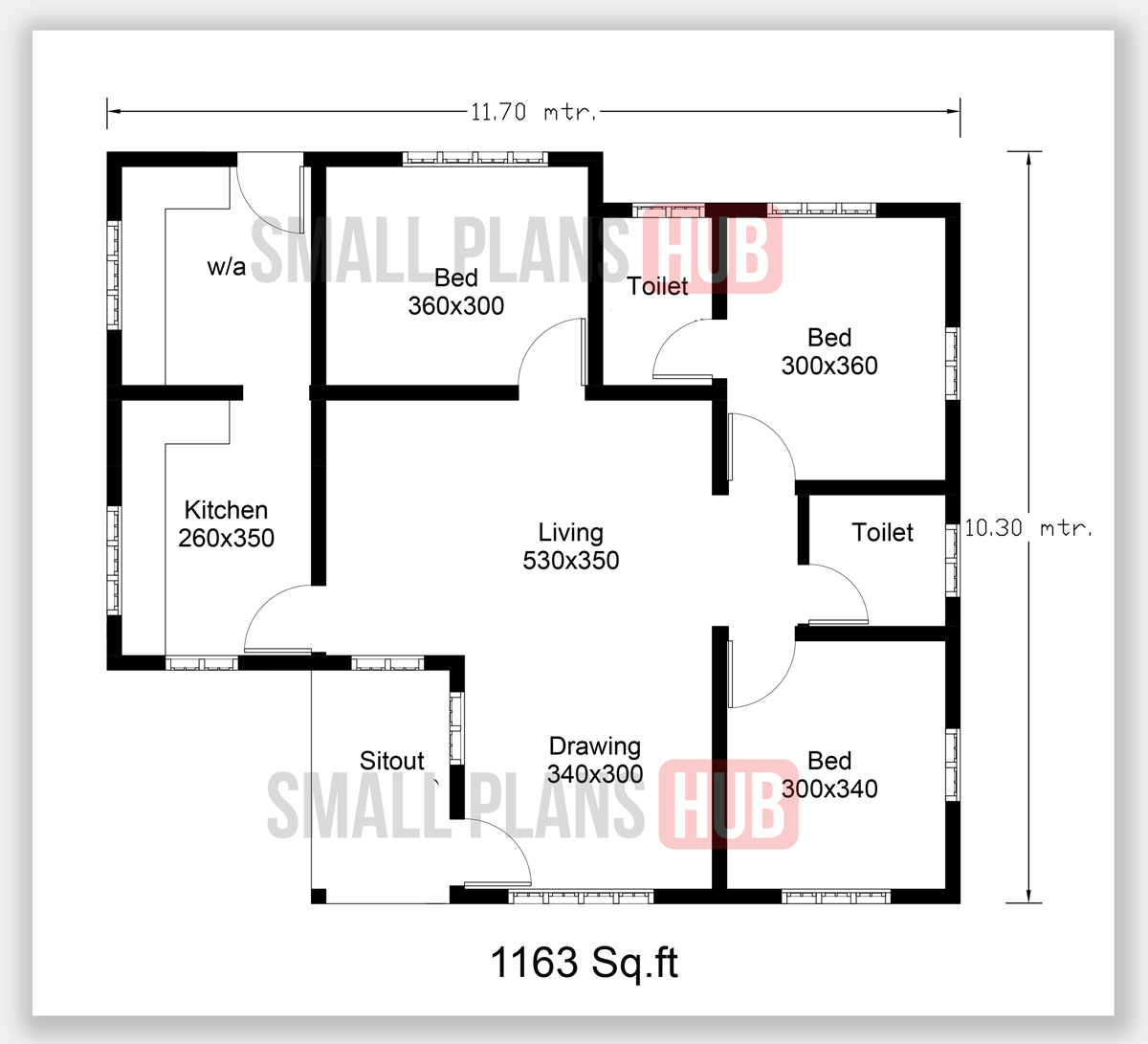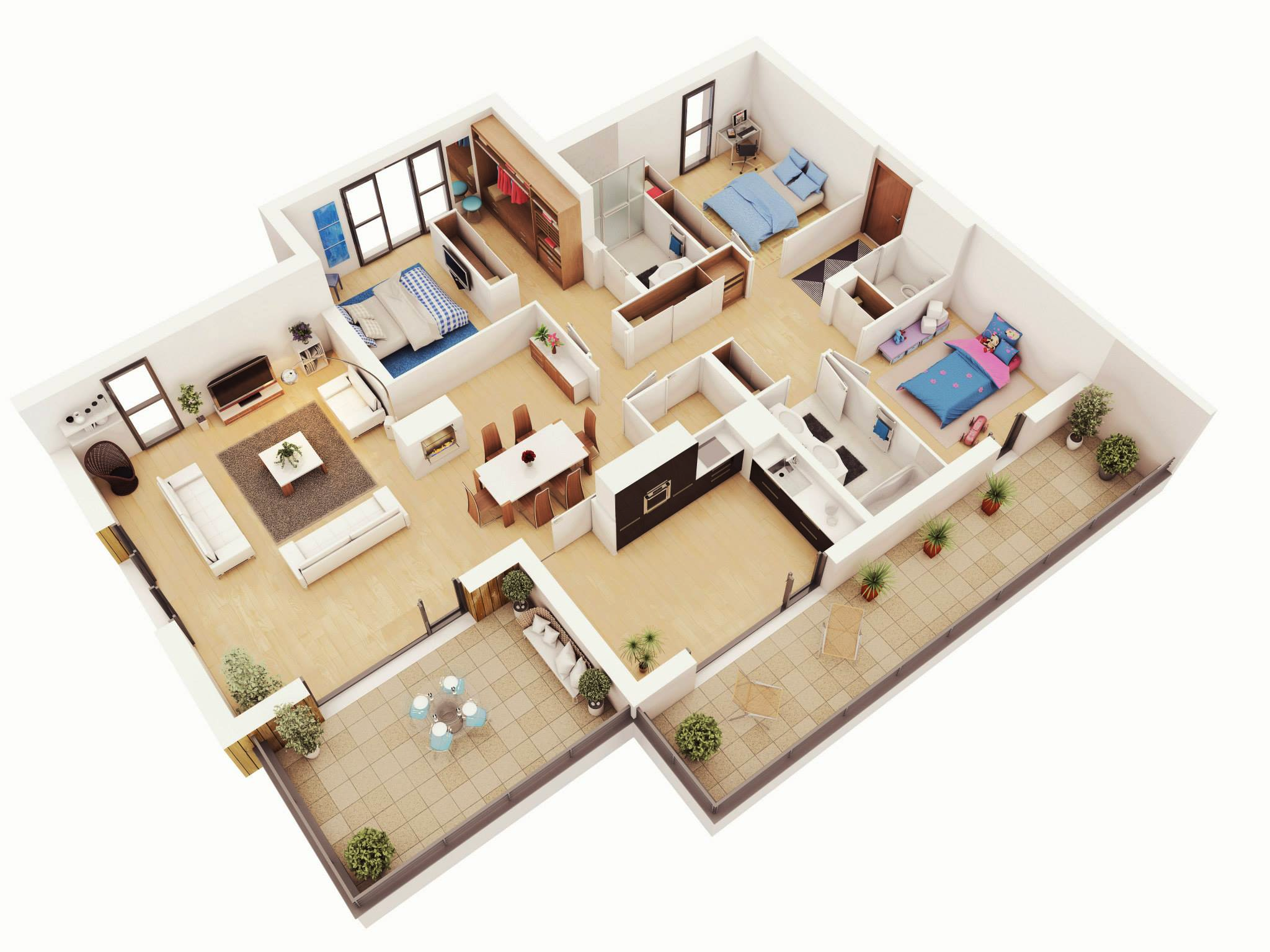Understanding 3 Bedroom Hall Kitchen House Plans

A 3 bedroom hall kitchen house plan is a common residential design that caters to the needs of small to medium-sized families. It typically features three bedrooms, a living room or hall, a kitchen, and essential utilities like bathrooms and a laundry area. These plans are popular due to their practicality, affordability, and ability to accommodate a range of lifestyles.
Typical Layout
The typical layout of a 3 bedroom hall kitchen house plan emphasizes functionality and efficient use of space. The bedrooms are usually situated in one area of the house, while the living room, kitchen, and dining area are often clustered together for easy access and social interaction. The kitchen is often positioned near the dining area for convenience. The hall serves as a central space for circulation and gathering. The bathroom and laundry area are usually placed in a separate zone for privacy.
Common Features and Functionalities
- Bedrooms: The three bedrooms provide comfortable accommodation for a family. They are often designed with ample storage space and natural light.
- Living Room or Hall: The living room or hall is a central gathering space for relaxation and entertainment. It typically features comfortable seating, a television, and possibly a fireplace.
- Kitchen: The kitchen is the heart of the home, where meals are prepared and shared. It usually includes essential appliances like a stove, oven, refrigerator, and sink.
- Bathrooms: The bathroom provides a private space for personal hygiene and relaxation. It typically includes a toilet, sink, and shower or bathtub.
- Laundry Area: The laundry area provides a convenient space for washing and drying clothes. It may include a washing machine, dryer, and storage for laundry supplies.
Architectural Styles
3 bedroom hall kitchen house plans can be adapted to various architectural styles, allowing homeowners to express their personal preferences.
- Traditional: This style features symmetrical facades, decorative details, and a focus on craftsmanship. It often includes elements like columns, gables, and porches. Examples include Colonial, Victorian, and Craftsman styles.
- Modern: This style emphasizes clean lines, geometric shapes, and minimalist aesthetics. It often incorporates large windows, open floor plans, and flat roofs. Examples include Mid-Century Modern and Contemporary styles.
- Contemporary: This style is a modern interpretation of traditional architecture, incorporating elements of both. It often features open floor plans, large windows, and a focus on natural materials.
- Rustic: This style is inspired by nature and emphasizes natural materials like wood and stone. It often features exposed beams, stone fireplaces, and a cozy atmosphere. Examples include Log Cabin and Farmhouse styles.
Advantages and Disadvantages of Different Layouts
- Open Floor Plan: This layout features minimal walls, creating a sense of spaciousness and openness. It can be ideal for social gatherings and family interaction, but it may also make it difficult to create privacy.
- Closed Floor Plan: This layout features more walls, creating separate rooms for different functions. It can provide more privacy and quiet spaces, but it may feel cramped and disconnected.
- Split-Level Layout: This layout features different levels connected by stairs. It can offer unique views and create distinct zones within the home, but it may require more stairs and be challenging for people with mobility issues.
Factors to Consider When Choosing a 3 Bedroom Hall Kitchen Plan

Choosing the right 3-bedroom hall kitchen house plan is crucial for ensuring a comfortable and functional living space. This involves careful consideration of various factors that directly impact the suitability and livability of the chosen plan.
Budget
The budget is a fundamental consideration when selecting a house plan. It sets the boundaries for the overall cost of construction, including materials, labor, and permits. It’s essential to establish a realistic budget and research the average construction costs in your area. This helps in narrowing down the selection to plans that align with your financial capabilities.
Family Size and Lifestyle
The size and lifestyle of your family play a significant role in choosing the right plan. A growing family might require a larger plan with ample space for bedrooms, bathrooms, and living areas. Conversely, a smaller family or individuals may find a more compact plan suitable. Consider the number of bedrooms, bathrooms, and living spaces needed to accommodate your family’s current and future needs.
Lot Size and Orientation
The size and orientation of your lot are critical factors in selecting a house plan. The plan should fit comfortably within the lot boundaries, leaving sufficient space for landscaping, driveways, and other amenities. The orientation of the house on the lot influences natural light exposure and energy efficiency. Consider the direction of sunlight and prevailing winds to optimize the plan for comfortable living.
Functionality and Aesthetics, 3 bedroom hall kitchen house plans
Functionality and aesthetics are equally important when choosing a house plan. Consider the flow of traffic within the house, the placement of rooms, and the overall layout. A well-designed plan should maximize space utilization, provide efficient movement between rooms, and create a comfortable and welcoming atmosphere. The architectural style, exterior finishes, and interior design elements contribute to the aesthetics of the house and should reflect your personal preferences.
Exploring Popular 3 Bedroom Hall Kitchen House Plan Variations

The world of 3-bedroom hall kitchen house plans offers a diverse array of options, catering to a wide spectrum of lifestyles and preferences. Understanding the key variations available can help you choose the plan that best suits your family’s needs and aspirations.
Variations in 3 Bedroom Hall Kitchen House Plans
This section explores various popular 3 bedroom hall kitchen house plan variations, highlighting their key characteristics, visual representations, pros and cons, and suitability for different lifestyles.
Plan Variations and Key Characteristics
| Plan Variation | Key Characteristics |
|---|---|
| Single-Story | All living spaces are on one level, ideal for families with young children or seniors, often featuring an open floor plan for easy accessibility. |
| Two-Story | Features a main living area on the ground floor and bedrooms on the upper floor, maximizing space and offering privacy. |
| Split-Level | Combines elements of single-story and two-story designs, often with a sunken living room or a lower level with bedrooms. |
| Open-Concept | Features a large, open space encompassing the living, dining, and kitchen areas, promoting a sense of spaciousness and connectivity. |
| L-Shaped | The living spaces are arranged in an L-shape, maximizing natural light and creating distinct zones for different activities. |
| U-Shaped | The living spaces are arranged in a U-shape, offering a central gathering area and distinct zones for various activities. |
Visual Representation of Plan Variations
- Single-Story: Imagine a spacious living area with an open kitchen, a dining space, and three bedrooms all conveniently located on the same level. The house has a wide front porch and a backyard with a patio for outdoor relaxation.
- Two-Story: Picture a grand entrance leading to an open living area on the ground floor, with a sweeping staircase leading to the upper level. The upper floor features three bedrooms, each with its own bathroom, and a shared hallway.
- Split-Level: Envision a house with the living room and kitchen on the main level, a lower level with bedrooms, and a partially elevated area that could be used as a study or playroom.
- Open-Concept: Imagine a seamless flow between the living room, dining area, and kitchen, creating a large, airy space perfect for entertaining.
- L-Shaped: Visualize a house with the living room and kitchen forming an L-shape, maximizing natural light and creating a sense of privacy in the dining area.
- U-Shaped: Picture a house with the living room, dining area, and kitchen arranged in a U-shape, creating a central gathering area and distinct zones for different activities.
Pros and Cons of Different Plan Variations
- Single-Story:
- Pros: Easy accessibility, ideal for families with young children or seniors, lower construction costs.
- Cons: May require more land, limited privacy between bedrooms.
- Two-Story:
- Pros: Maximizes space, offers privacy between bedrooms, potential for a larger footprint.
- Cons: Higher construction costs, may not be suitable for seniors or individuals with mobility challenges.
- Split-Level:
- Pros: Combines features of single-story and two-story designs, offers a unique and interesting layout.
- Cons: May require more land, can be challenging to navigate.
- Open-Concept:
- Pros: Creates a sense of spaciousness, promotes connectivity between family members, ideal for entertaining.
- Cons: May lack privacy, noise can be amplified.
- L-Shaped:
- Pros: Maximizes natural light, creates distinct zones for different activities.
- Cons: May be challenging to navigate, could limit furniture placement options.
- U-Shaped:
- Pros: Creates a central gathering area, offers distinct zones for various activities, can be very efficient in terms of space utilization.
- Cons: May feel enclosed, could be challenging to decorate.
Suitability of Plan Variations for Different Lifestyles and Needs
- Single-Story: Ideal for families with young children, seniors, or individuals with mobility challenges, as it eliminates stairs and provides easy access to all living spaces.
- Two-Story: Well-suited for families who value privacy and need ample space for bedrooms and bathrooms.
- Split-Level: Offers a unique and versatile layout that can be adapted to suit various lifestyles, from young families to empty nesters.
- Open-Concept: Best suited for families who enjoy a sense of spaciousness and connectivity, and often entertain guests.
- L-Shaped: Ideal for families who prioritize natural light and distinct zones for different activities.
- U-Shaped: Well-suited for families who desire a central gathering area and efficient space utilization.